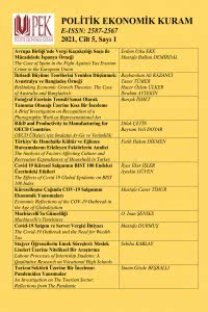Sermaye Kontrolünün Portföy Yatırımları Üzerindeki Etkisi: Malezya Örneği
Gelişmekte olan ülkeler doğrudan yatırımları ülkelerine çekebilmek, kolaylıkla borçlanabilmek veya tasarruf açıklarını kapatabilmek hedefleriyle sınırlarını yabancı sermayeye açmaktadırlar. Döviz ihtiyacına cevap vermesi ve kurlar üzerindeki baskıyı azaltması gibi avantajlarına karşın kısa vadeli sermaye hareketleri finansal kırılganlığa sebebiyet verebilmektedir. Bu kırılgan yapıya izin vermemek veya gelir elde etmek gibi amaçlarla uygulanması düşünülen sermaye kontrollerinin yarattığı etkilere yönelik araştırmalara literatürde sıklıkla rastlanmaktadır. Bu çalışmanın amacı, sermaye kontrolü uygulamış olan Malezya’da sermaye kontrolünün portföy yatırımları üzerinde ortaya çıkardığı etkiyi test etmektir. Gerçekleştirilen VAR (Vector Autoregression) analizi sonuçlarına göre sermaye kontrolünün gevşetilmesi (finansal serbestlik endeksindeki artış) portföy yatırımlarını pozitif yönde etkilemektedir. Çalışmanın, finansal serbestleşme ile sermaye hareketleri arasındaki ilişkiyi Malezya örneği kapsamında ele alması yönüyle, ilgili yazına katkı sağlaması beklenmektedir.
Anahtar Kelimeler:
Sermaye Hareketleri, Sermaye Kontrolü, Finansal Serbestlik, Malezya
The Effect of Capital Control on Portfolio Investments: The Case of Malaysia
Developing countries open their borders to foreign capital with the aim of attracting foreign direct investments or loans. Short-term capital flow can cause financial fragility in spite of obvious advantages such as responding to foreign exchange requirements and reducing the pressure on exchange rates. Effectiveness of capital controls that can be applied with the purpose of generating income and preventing a fragile structure in the economy are frequently discussed in the literature. The aim of the research is to test the impact of capital control on portfolio investments in Malaysia which has implemented capital control. According to the results of the VAR (Vector Autoregression) analysis, a decrease in capital controls (increase in financial openness index) creates positive effect on portfolio investments. The study is expected to contribute to the related literature in terms of dealing with the link between financial liberalization and capital movements within the scope of Malaysia.
Keywords:
Capital Flows, Capital Control, Financial Openness, Malaysia,
___
- Abdelal, R. ve Alfaro, L. 2003. Capital and Control: Lessons from Malaysia. Challenge, 46(4), 36–53.
- Ahmad, F. 2015. Determinants of Savings Behavior in Pakistan: Long Run - Short Run Association and Causality. Timisoara Journal of Economics and Business, 8(1), 103–136.
- Baba, C. ve Kokenyne, A. 2011. Effectiveness of Capital Controls in Selected Emerging Markets in the 2000s (IMF Working Paper No. WP/11/281).
- Bang Vu, T. 2005. Capital Controls:The Case of Malaysia and Lessons for Vietnam (East-West Center Working Papers No. 19). Honolulu.
- Chinn, M. D. ve Ito, H. 2006. What Matters for Financial Development? Capital Controls, Institutions, and Interactions. Journal of Development Economics, 81(1), 163–192.
- Çögürcü, İ. 2015. Türkiye’de Kredi Kartı Harcamaları Ve Vergi Gelirleri İlişkisi: Vektör Otoregresif Model İle Analizi (2007-2015). Süleyman Demirel Üniversitesi İİBF Dergisi, 20(4), 241–260.
- De Gregorio, J., Edwards, S. ve Valdés, R. O. 2000. Controls on Capital Inflows: Do They Work? Journal of Development Economics, 63(1), 59–83.
- Desai, M. A., Foley, C. F. ve Hines R., J. J. 2006. Capital Controls , Liberalizations , and Foreign Direct Investment. The Review of Financial Studies, 19(4), 1433–1464.
- Forbes, K., Fratzscher, M., Kostka, T. ve Straub, R. 2016. Bubble Thy Neighbour: Portfolio Effects and Externalities from Capital Controls. Journal of International Economics, 99(2016), 85–104.
- Forbes, K., Fratzscher, M. ve Straub, R. 2013. Capitals Controls and Macroprudential Measures: What Are They Good For? (DIW Discussion Papers No. 1343). Berlin.
- Inoguchi, M. 2009. Did Capital Controls Decrease Capital Flows in Malaysia? Journal of the Asia Pacific Economy, 14(1), 27–48.
- Johnson, S. ve Mitton, T. 2003. Cronyism and Capital Controls: Evidence from Malaysia. Journal of Financial Economics, 67, 351–382.
- Kaplan, E. ve Rodrik, D. 2001. Did The Malaysian Capital Controls Work ? (NBER Working Paper Series No. 8142). Cambridge, MA.
- Labán, R. M. ve Larraín, F. B. 1997. Can a Liberalization of Capital Outflows Increase Net Capital Inflows? Journal of International Money and Finance, 16(3), 415–431.
- Li, J. ve Rajan, R. S. 2015. Do Capital Controls Make Gross Equity Flows To Emerging Markets Less Volatile? Journal of International Money and Finance, 59(2015), 220–244.
- Magud, N. E., Reinhart, C. M. ve Rogoff, K. S. 2018. Capital Controls: Myth and Reality. Annals of Economics and Finance, 19(1), 1–47.
- Mercado, R. V. ve Park, C.-Y. 2011. What Drives Different Types of Capital Flows and their Volatilities in Developing Asia? International Economic Journal, 25(4), 655–680.
- Mitchell, H. ve Joseph, S. 2010. Changes in Malaysia: Capital Controls, Prime Ministers and Political Connections. Pacific Basin Finance Journal, 18(5), 460–476.
- Montiel, P. ve Reinhart, C. M. 1999. Do Capital Controls and Macroeconomic Policies Influence the Volume and Composition of Capital Flows? Evidence from the 1990s. Journal of International Money and Finance, 18(4), 619–635.
- Özgen, F. B. ve Güloğlu, B. 2004. Türkiye’de İç Borçların İktisadî Etkilerinin VAR Tekniğiyle Analizi. ODTÜ Gelişme Dergisi, 31, 93–114.
- Prieto-Valdes, S. ve Soto, M. 1998. The Effectiveness of Capital Controls: Theory and Evidence from Chile ? Empirica, 25(2), 133–164.
- Sarı, A. 2007. Faiz Kanalı Yoluyla Türkiye’de Parasal Aktarım Mekanizmalarının İşlerliği. Akademik Fener, 5(8), 15–21.
- The Economist. 2013. Do Tobin Taxes Actually Work. https://www.economist.com/blogs/economist-explains/2013/09/econ omist-explains-1, (Erişim Tarihi: 10 Mart 2018).
- Yalta, A. Y. 2010. Effect of Capital Flight on Investment: Evidence from Emerging Markets. Emerging Markets Finance and Trade, 46(6), 40–54.
- Yayın Aralığı: Yılda 4 Sayı
- Başlangıç: 2017
- Yayıncı: Ahmet Arif EREN
Sayıdaki Diğer Makaleler
Sermaye Kontrolünün Portföy Yatırımları Üzerindeki Etkisi: Malezya Örneği
Birinci Dünya Savaşından Önce Almanya – Osmanlı İlişkileri
Feodalizmden Kapitalizme Geçiş Tartışmalarında Toplumsal Dönüşüm Anlayışının Yeri
19.Yüzyılda Osmanlı Ve Japon İmparatorluğu’nun Modernleşme Politikalarının Karşılaştırmalı Analizi
Ağ Teorisinin Temelleri ve Evrimi: Bütünsel Bir Değerlendirme
Sevim UNUTULMAZ, Murat Ali DULUPÇU
Adana Şehir Hastanesi’nde Hasta Memnuniyetine Yönelik Bir Araştırma
Emre SARCAN, Gülbiye YENİMAHALLELİ YAŞAR
Weberyen Bürokrasi Bağlamında Türkiye’de İç Güvenlik Bürokrasisi
Hasan Alpay KARASOY, Mustafa YENİKAYNAK
Piyasalar ve İktisadi Kurumlar: Yeni Ekonomik Sosyoloji Ciddi Bir Rakip Mi?
